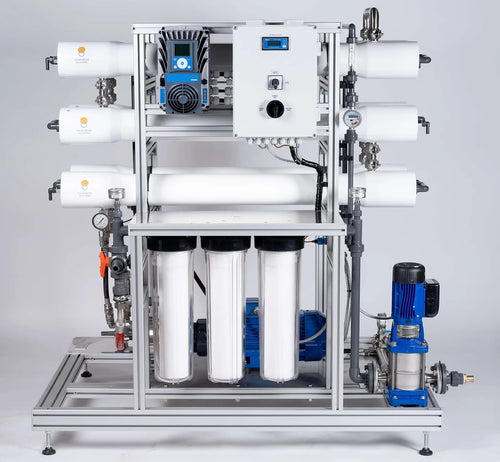Using compression fittings on poly ag pipe
If you want to move water from one place to another on your property, you will probably use poly pipe, or "ag" (agricultural) pipe. Ag pipe comes in a range of sizes, from 3/4 inch to 2 inch nominal diameter, and in high and low pressure ratings (900 and 800 kPa respectively). The larger the diameter, the more you will pay for the pipe and the fittings, but the less energy you will need to pump water through the pipe for a given flowrate.
When you have decided what size pipe and which pressure you want, you will probably need some fittings. The fittings are "compression" fittings, which means they use a "ferrule" and an o-ring compressed to the pipe to seal the fitting. (Would you believe that there is a Wikipedia article that explains this?).
When buying fittings, make sure you get the right size, and the right pressure rating, as its very difficult to get the high-pressure fittings to work with the low-pressure pipe! The high-pressure pipe has thicker walls, so it needs different fittings. Also try to stick to one brand so that you can swap the parts around.
If you need to connect to a tank, a trough or a pump, for example, you will probably also need a normal screw-in fitting, so you will have a compression fitting on the end that connects to the pipe and a screw-in fitting on the other end. You may also then need other bits and pieces to change the size (reducers and expanders).
Pete is really good at picking through all the bits in the ag supply store and building a fitting that works (they don't always have exactly what we need), don't be afraid to mix and match, often there are a number of possible options, so play around until you find the easiest or cheapest way to what you need to do.
Pete is also good at installing the fittings, which he did when we connected the 900m of ag pipe in 100m sections from our solar bore pump to the highest point on our property. You will need a hack-saw, a file and a soft mallet (and a lot of patience if someone is taking photos of every step, this post was made possible by Pete!).
First cut the end of the pipe square with the saw. Then file any rough edges inside and outside, to make sure the pipe will seal evenly. Pete has a clever scraper tool to do the inside, but a file would also work. Then slip the outer compression nut (the big piece on the right in the photo below) onto the pipe, then the ferrule, and then gently tap the inner piece into the pipe (it might need some force, but try not to damage it and don't lose the o-ring).
Finally, you can screw the outer compression nut into the middle part of the fitting (far-left). It doesn't need to be extremely tight, because its actually the ferrule and the o-ring that are sealing the pipe, and you might want to get it undone again one day, so just tighten it without using any tools for extra leverage. When you have finished, you can check for leaking fittings and tighten more if required.
| (left to right: the middle part, the bit that goes inside the pipe, the ferrule, and the outer compression nut) |
The only trouble we have had with these fittings is trying to combine low and high pressure fittings and pipe, and when the ag supply store doesn't have exactly what we need. Now we know what to look for, its been much easier! And now we try to stick to one brand, so that we can interchange parts. We installed t-sections on all the joins this time, so that we can connect to troughs if we want to, but we could also remove the t-sections and install blank joiners later if we want to.
Have you used compression fittings for ag pipe? Any tips?
Here's the step-by-step photos
 |
| Cutting the end square - important for making the seal work |
| Filing the end |
| putting it together |
| Tightening the fitting |
| The finished product |
More from:
water




















Leave a comment